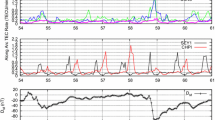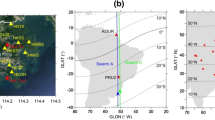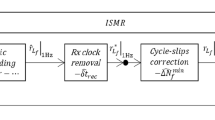Abstract
Ionospheric scintillation is a challenging issue for the Global Navigation Satellite System (GNSS). Data collected by the globally distributed GNSS receivers provide abundant information about the ionosphere. S4 is one of the most important parameters of the scintillation, which can be measured by the GNSS receivers. We established a simplified probability model for S4 measured by the GNSS receiver. This model fully considers the correlation of the signal intensity and the ambient noise introduced by the receiver. A factor that reveals the correlation feature of scintillated intensity was proposed. Based on this model, the Cramer–Rao bound (CRB) and the minimum-variance unbiased estimator for S4 were deduced and analyzed. The CRB shows that the uncertainty of S4 increases as the scintillation becomes severe and the decorrelation time becomes longer. Then an approximate probability model was established to describe the statistics of the common estimator of S4. Simulation tests were carried out to validate the proposed model. Based on the approximate model, the statistics of the common estimator was analyzed. We found that, apart from ambient noise, the variation of signal intensity leads to a minus bias for S4 measurements, which seems to have been neglected in the past. A method to correct this bias was proposed. We also found that the increase in the carrier-to-noise ratio decreases the bias but helps little in reducing the variance of the measurements. Considering the accuracy of S4 measurements and the robustness of the tracking loop, we found that for weak scintillation, the value 0.02 s is an ideal coherent time. For moderate scintillation, a relatively ideal coherent time is 0.004 s and for severe scintillation, 0.001 s is an ideal coherent time. Based on this analysis, suggestions for GNSS receiver configurations were proposed.













Similar content being viewed by others
Data availability
Cornell Scintillation Simulator generated the data used in this paper. The original MATLAB code could be found at https://gps.ece.cornell.edu/tools.php.
References
Acharya R, Majumdar S (2019) Statistical relation of scintillation index S4 with ionospheric irregularity index ROTI over Indian equatorial region. Adv Sp Res 64:1019–1033. https://doi.org/10.1016/j.asr.2019.05.018
Bai W et al (2018) Validation results of maximum S4 index in F-layer derived from GNOS on FY3C satellite. GPS Solut 23(1):19. https://doi.org/10.1007/s10291-018-0807-x
Bandyopadhayay T, Guha A, DasGupta A, Banerjee P, Bose A (1997) Degradation of navigational accuracy with Global Positioning System during periods of scintillation at equatorial latitudes. Electron Lett 33(12):1010–1011. https://doi.org/10.1049/el:19970692
de Oliveira MA, de Paula ER, Perrella WJ, da Silveira RF (2013) On the distribution of GPS signal amplitudes during low-latitude ionospheric scintillation. GPS Solut 17(4):499–510. https://doi.org/10.1007/s10291-012-0295-3
de Paula ER et al (2019) Ionospheric irregularity behavior during the September 6–10, 2017 magnetic storm over Brazilian equatorial–low latitudes. Earth, Planets Sp 71(1):42. https://doi.org/10.1186/s40623-019-1020-z
Dierendonck AJV, Hua Q, Fenton P, Klobuchar J (1996) Commercial ionospheric scintillation monitoring receiver development and test results. In: Proceedings of ION GNSS 1996, Institute of Navigation, Cambridge MA, pp 573–582
Fremouw EJ, Livingston RC, Miller DA (1980) On the statistics of scintillating signals. J Atmos Terr Phys 42(8):717–731. https://doi.org/10.1016/0021-9169(80)90055-0
Hey JS, Parsons SJ, Phillips JW (1946) Fluctuations in cosmic radiation at radio-frequencies. Nature 158(4007):234–234. https://doi.org/10.1038/158234a0
Hoeffding W, Robbins H (1948) The central limit theorem for dependent random variables. Duke Math J 15(3):773–780. https://doi.org/10.1215/S0012-7094-48-01568-3
Humphreys TE, Psiaki M, Hinks JC, O'Hanlon B, Paul MJK (2009) Simulating ionosphere-induced scintillation for testing GPS receiver phase tracking loops. IEEE J Sel Top Signal Process 3(4):707–715. https://doi.org/10.1109/JSTSP.2009.2024130
Humphreys TE, Psiaki M, Ledvina BM, Cerruti AP, Paul MJK (2010) Data-driven testbed for evaluating GPS carrier tracking loops in ionospheric scintillation. IEEE Trans Aerosp Electron Syst 46(4):1609–1623. https://doi.org/10.1109/TAES.2010.5595582
Jiao Y, Hall J, Morton YT (2017) Performance evaluation of an automatic gps ionospheric phase scintillation detector using a machine learning algorithm. Navigation 64(3):391–402. https://doi.org/10.1002/navi.188
Juan J et al (2018) Feasibility of precise navigation in high and low latitude regions under scintillation conditions. J Sp Weather Sp Clim 8:A05. https://doi.org/10.1051/swsc/2017047
Kay SM (1995) Fundamentals of statistical signal processing: estimation theory. Prentice Hall, Upper Saddle River, New Jersey
Ke F, Wang J, Tu M, Wang X, Wang X, Zhao X, Deng J (2019) Characteristics and coupling mechanism of GPS ionospheric scintillation responses to the tropical cyclones in Australia. GPS Solut 23(2):34. https://doi.org/10.1007/s10291-019-0826-2
Meng X, Fang H, Li G, Weng L (2017) Statistical characteristics of locally generated ESF during equinoctial months over Sanya. Adv Space Res 61(9):2227–2233
Moraes AdO et al (2018) GPS availability and positioning issues when the signal paths are aligned with ionospheric plasma bubbles. GPS Solut 22(4):95. https://doi.org/10.1007/s10291-018-0760-8
Pi X, Iijima BA, Lu W (2017) Effects of ionospheric scintillation on GNSS-based positioning. Navigation 64(1):3–22. https://doi.org/10.1002/navi.182
Salinas CCJH (2018) On the relationship between E region scintillation and ENSO observed by FORMOSAT-3/COSMIC. J Geophys Res Sp Phys 123(5):4053–4065. https://doi.org/10.1029/2018JA025299
Simon MK, Alouini M-S (2005) Digital communication over fading channels. Wiley, New York
Sun Y, Sun G, Xiaomei T, Huang Y (2016) Wavelet de-noising Kalman filter-based GNSS carrier tracking in presence of ionospheric scintillation. IET Radar Sonar Navig 11(2):226–234. https://doi.org/10.1049/iet-rsn.2015.0663
Tsai L-C, Su S-Y, Liu C-H (2017) Global morphology of ionospheric F-layer scintillations using FS3/COSMIC GPS radio occultation data. GPS Solut 21(3):1037–1048
Urkowitz H (1967) Energy detection of unknown deterministic signals. Proc IEEE 55(4):523–531. https://doi.org/10.1109/PROC.1967.5573
Vani BC et al (2019) A novel approach to improve GNSS precise point positioning during strong ionospheric scintillation: theory and demonstration. IEEE Trans Veh Technol 68(5):4391–4403. https://doi.org/10.1109/TVT.2019.2903988
Whitney HE, Aarons J, Allen RS, Seemann DR (1972) Estimation of the cumulative amplitude probability distribution function of ionospheric scintillations. Radio Sci 7(12):1095–1104. https://doi.org/10.1029/RS007i012p01095
Xu N, Morton TY (2017) A semi-open loop GNSS carrier tracking algorithm for monitoring strong equatorial scintillation. IEEE Trans Aerosp Electron Syst 54(2):722–738. https://doi.org/10.1109/TAES.2017.2764778
Xu D, Morton YTJ (2018) GPS navigation data bit decoding error during strong equatorial scintillation. GPS Solut 22(4):110. https://doi.org/10.1007/s10291-018-0775-1
Acknowledgements
We thank Mr. Humphreys and his co-workers for providing the simulation code of ionospheric scintillation. This research was supported by the National Natural Science Foundation of China (Grant Nos. 41405039, 41775034, 41405040, 41505030 and 41606206), the Strategic Priority Research Program of Chinese Academy of Sciences (Grant No. XDA15007501), the Scientific Research Project of the Chinese Academy of Sciences (Grant No. YZ201129).
Author information
Authors and Affiliations
Corresponding author
Additional information
Publisher's Note
Springer Nature remains neutral with regard to jurisdictional claims in published maps and institutional affiliations.
Rights and permissions
About this article
Cite this article
Tian, Y., Wang, X., Sun, Y. et al. Error analysis on ionospheric scintillation index S4 measured by GNSS receiver. GPS Solut 24, 75 (2020). https://doi.org/10.1007/s10291-020-00987-y
Received:
Accepted:
Published:
DOI: https://doi.org/10.1007/s10291-020-00987-y




